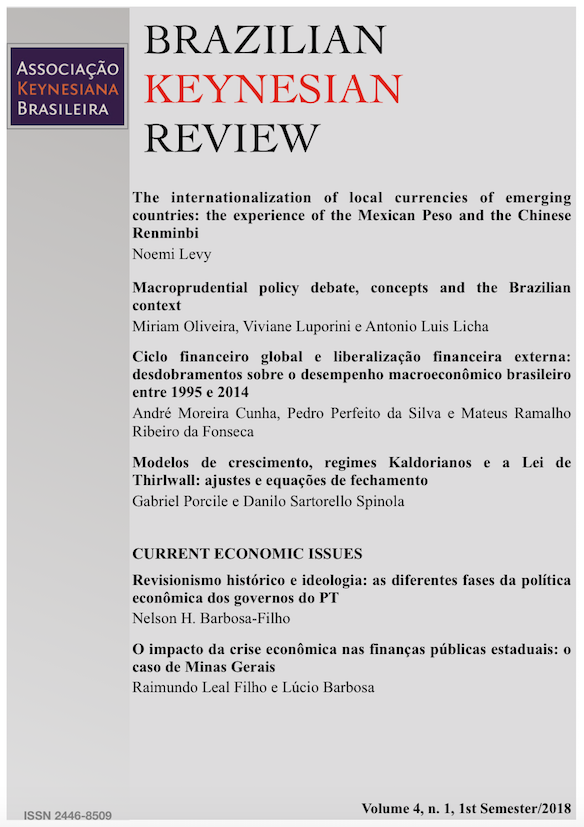The internationalization of local currencies of emerging countries: the experience of the Mexican peso and the Chinese renminbi
Resumo
Globalization introduced private and structural endogenous money (private monetary debts) as the main instrument of financial capital mobilization in the international financial system. A main consequence of this feature was the internalization of emerging economies currencies unfolding two successful experiences: the foreign exchange transactions related to the Mexican peso and the Chinese renminbi. The former currency internationalized as a result of the institutional changes unfolded in the Mexican economy and it’s insertion to the North American region (NAFTA); while the latter stemmed from a government strategy to influence the worldwide economy as a result of its accelerated economic growth and increased importance in the world economy. In this paper are discussed three main themes: the way in which emerging economies currencies internationalized; the insertion of these economies in the international market, and the divergent developments of successful currency internationalization.
Downloads
Referências
Avdjiev, S.; McCauley, R. and Shin, H. (2015) “Banking free of the triple coincidence in international finance”, BIS Working paper, n.534.
Gutiérrez, E.; Bernardino, A. and Gutiérrez, J. (2014) “La evolución del mercado global de divisas y su situación en el contexto de la crisis financiera”, Boletín Económico de ICE n.3049, p. 3-14.
BIS (2001) Triennial Central Bank Survey, Foreign exchange and derivatives market activity in 2001. Statistical Annex Tables. Available at https://www.bis.org/publ/rpfx02t.pdf. Accessed on 13/08/2018.
BIS (2004) Triennial Central Bank Survey Foreign exchange and derivatives market activity in 2004. Statistical Annex Tables. Available at https://www.bis.org/publ/rpfx05t.pdf. Accessed on 13/08/2018.
BIS (2007) Triennial Central Bank Survey Foreign exchange and derivatives market activity in 2007, Statistical Annex Tables. Available at https://www.bis.org/publ/rpfxf07t.pdf. Accessed on 13/08/2018.
BIS (2010) Triennial Central Bank Survey. Report on Global Foreign Exchange market activity in 2011. Available at https://www.bis.org/publ/rpfxf10t.pdf. Accessed on 13/08/2018.
BIS (2013) Triennial Central Bank Survey. Global foreign exchange market turnover in 2013. Tables revised, published in February 2014. Available at https://www.bis.org/publ/rpfxf13fxt.pdf. Accessed on 13/08/2018.
BIS (2016) Triennial Central Bank Survey, Foreign exchange turnover in April 2016. Tables revised September 1st. 2016. Available at https://www.bis.org/publ/rpfx16fx.pdf. Accessed on 13/08/2018.
Borio, C and Disyatat, P. (2015) “Capital flows and the current account: Taking financing (more) seriously”, BIS Working Papers, n.525.
Bossone, B. (2003) “Thinking of the Economy as a circuit” in: L-P. Rochon and S. Rossi (eds.) Modern Theories of Money: the nature and role of money in capitalist economies, Cheltenham, UK; Northhampton, US: Edward Elgar, p. 142-172.
Cepal (1949 [1998]) “Estudio Económico de América Latina” In: R. Bielschowsky (org.), Cincuenta Años de Pensamiento en la Cepal: textos seleccionados, v.1, Santiago, Chile: Fondo de Cultura Económica-Cepal, p.131-172.
Chang, H-J. and Grabel, I. (2004) Reclaiming development, London and New York: Zed Book Ltd., p. 135-139.
De Cecco, M. (2012) “Global imbalances: past, present, and future”, Contributions to Political Economy, 31(1), pp. 29–50.
Eatwell, J. and Taylor, L. (2000) Global finance at risk: the case for international regulation, New York: The New Press.
Epstein G. (2005). Financialization and the world economy, Cheltenham, U.K.: Edward Elgar Publishing.
Copyright (c) 2018 Noemi Levy-Orlik

This work is licensed under a Creative Commons Attribution 4.0 International License.
- Autores mantém os direitos autorais e concedem à revista o direito de primeira publicação, com o trabalho simultaneamente licenciado sob a Licença Creative Commons Attribution que permite o compartilhamento do trabalho com reconhecimento da autoria e publicação inicial nesta revista.
- Autores têm autorização para assumir contratos adicionais separadamente, para distribuição não-exclusiva da versão do trabalho publicada nesta revista (ex.: publicar em repositório institucional ou como capítulo de livro), com reconhecimento de autoria e publicação inicial nesta revista.
- Autores têm permissão e são estimulados a publicar e distribuir seu trabalho online (ex.: em repositórios institucionais ou na sua página pessoal) a qualquer ponto antes ou durante o processo editorial, já que isso pode gerar alterações produtivas, bem como aumentar o impacto e a citação do trabalho publicado (Veja O Efeito do Acesso Livre).


